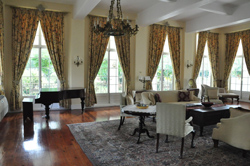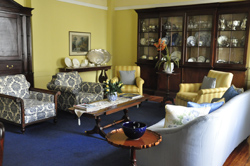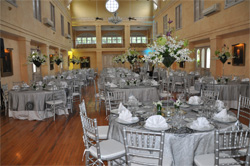
Front View of King’s House
The chronological list of Governors of Jamaica records the first Governor to Jamaica as early as 1661 as General Edward D’Oyley. At this time, the country was a Crown Colony of Great Britain. There was no official residence for Governors then and they resided wherever they wished and even lodged with the members of the Executive Council of the government of that era.
The need for the Governors to have a permanent place to live in Britain’s colonies brought about King’s House. The official residence of Governors of Jamaica have always been called King’s House even during the reign of Queens.

South View of King’s House
By the year 1690 there was already a King’s House in Port Royal. Then Governor George William O’Brien, Second Earl of Inchiquin requested that a new King’s House be built in St. Jago De La Vega of the St. Catherine District. Plans for the King’s House in Spanish Town were prepared by Thomas Craskell, the Engineer of the island and the building was completed in 1762 while Sir William Henry Lyttleton was Governor a position he held from (1762-1766). King’s House in Spanish Town was obviously a building of considerable importance at that time.
The capital was changed from Spanish Town to Kingston in 1872. The Governor at that time, Sir John Peter Grant, who served as Governor from 1866 to 1874 chose Somerset Pen, now known as King’s House Lands, on which was located the traditional home of the Anglican Lord Bishop of the Diocese of Jamaica for forty-six years to build the new King’s House.

South Eastern View of King’s House
The government bought the property for six thousand pounds. It was ideal, because the Governor resided in the Lodge while a new King’s House was built around it. The remodelled King’s House cost eight thousand pounds and the process of remodelling took two years. This King’s House remained until 1907 when it was destroyed by earthquake.
An architect from London, Sir Charles Nicholson, was called in to supervise restoration. In 1908 however, fire destroyed a coach house, the stables and some of the menservants’ rooms. These were all rebuilt within a year.
The present King’s House has a very similar structural appearance to the house after reconstruction in 1907.

The Foyer
The ‘Old King’s House’ in Spanish Town was destroyed by fire in 1925. It remained in ruin until 1932. At the time, Lady Slater, wife of Governor Alexander Ransford Slater (1932-1934), collected a sum of money which was used to preserve certain sections of the building’s structure. Another phase of the restoration was done by Sir Kenneth Blackburne during his tenure.
GROUNDS & GARDEN
The first lawn at King’s House was planted by John Peter Grant, who also had the garden professionally laid out. The most exceptional feature of the grounds is the mile-long driveway flanked by palms and aptly named Palm Tree Avenue.

The Ballroom
Sir William Grey who was the next Governor, from (1874 to 1877), changed all this and the lawns and gardens were transformed into vegetable and food plots, and grazing lands. Fortunately in 1877, he was replaced by Governor, Sir Anthony Musgrave who, along with his wife, Lady Musgrave, restored the gardens to their former glory. Sir Anthony Musgrave was Governor from 1877 to 1880.
A variety of trees adorn the gardens. Most outstanding are the awesome cotton trees imported from South Africa. Frederick George of England while on a visit planted a mango tree.
Queen Elizabeth II, the Duke of Edinburgh and Prince Charles, have all planted lignum vitae trees on the grounds during their visits. In addition to mahoe and banyan trees – brought in from India, there are flowers, ferns and plants from all over the world.

Governor-General’s Office
Jamaica House, set on thirty acres of land which was formerly a part of King’s House lands, was built in 1973 as the official residence of the Prime Minister of Jamaica. This building now houses the Office of the Prime Minister.
Each year on National Heroes Day, the grounds are used for the official ceremony during which the Governor General presents National Honours and Awards to deserving citizens.
The grounds on which King’s House is situated was originally known as “Somerset Pen”. In 1826 the property was sold to King George IV for £5,000 and held in trust as the residence for the Lord Bishop of the Diocese of Jamaica.
The property, which consisted of about 190 acres was bought by the Government for £6,000, to be the official residence for Governors following the transfer of the capital to Kingston from Spanish Town. The Old King’s House in Spanish Town has been preserved.
An additional £2,000 was spent renovating the house so as to provide an immediate temporary residence for the Governor. Later improvements made it suitable as the permanent official residence of the Governor.

Governor-General’s Office
Sir John Peter Grant, the then Governor beautified the grounds. Fine lawns, gardens and avenue of palm trees were planted. His successor Sir William Grey converted the front of the house to the side, and the side into the front at great cost, but neglected the gardens. The next occupants, Sir Anthony and Lady Musgrave, re-established the gardens, and the grounds have been well kept since.
King’s House was destroyed in the 1907 earthquake. Reconstruction was started in the same year, and the architect, Sir Charles Nicholson skilfully incorporated a portion of the remains of the old structure into the present King’s House.
The new structure, has a curious arrangement of buttresses on the ground and second floors.
King’s House has offered hospitality to a long line of distinguished visitors to Jamaica, including royal personages, presidents, states men and others.
THE HOUSE

The Dining Room
The house covers approximately 4,876.8 metres. It comprises three storeys. Ground floor rooms are arranged around an open patio.
Situated on the ground floor is the ballroom, where portraits of past Governors, Governors General, Queens and Kings are kept and where balls and other state and ceremonial functions are held. The foyer, the official entrance of King’s House and the office of the Aide de Camp, who is the personal bodyguard of the Governor General are also housed on this floor. The dining room, kitchen and pantry complete this floor.
A set of three silver lamps which were presented by the British Government during Independence celebrations in 1962 are on display in the foyer.
The office of the Governor General, morning, drawing and public rooms are situated on the principal floor. The morning room, contains an amalgam of antique and modern furniture.

The Drawing Room
The drawing room contains the hurricane globe chandeliers adorned with golden leaves which were original items brought from King’s House in Spanish Town. This spacious room is used for such occasions as the swearing in of Ministers of Government and Judges of the High Court.
The top or upper floor consists of the master bedroom and a beautifully furnished residential space.
VISITORS

The Drawing Room
Throughout the history of Jamaica there have been numerous royal visits to this country. King’s House is the home of visiting royalties and Heads of State.
- Prince Albert and Prince George of Wales visited Jamaica in 1880.
- In 1891 the Duke of Windsor visited and Prince George returned to open the great Jamaican Exhibition.
- Prince Albert visited in 1913.
- The Duke and Duchess of York came to Jamaica in 1927.
- King George the sixth and Her Majesty Queen Elizabeth II were here in 1931
- Queen Elizabeth II and her husband the Duke of Edingburgh were visitors in November 1953.
-

The Morning Room
Her Royal Highness Princess Margaret came in 1962 to represent the Queen at the first official opening of Parliament in Independent Jamaica. She was accompanied by her husband Lord Snowdon.
- His Imperial Majesty Haile Selassie, Emperor of Ethiopia, visited in 1966.
- Princess Anne spent her honeymoon here in December 1973.
- Prince Edward visited on April 23, 1992, for five days.
- Queen Elizabeth II and her husband the Duke of Edinburgh visited for a second time on March 1-3, 1994.
- Queen Elizabeth II visited in 2002
RESIDENTS OF KING’S HOUSE

The Ballroom decorated
Between 1874 when the first King’s House was built and now, there have been over thirty ‘caretakers’ of this country. Their titles range from President, Governor, Lieutenant-Governor, to Governor General. They have all reigned for varying numbers of years.
The most dedicated ones who made an impact on development in Jamaica are:-
Sir John Peter Grant Governor 1866 -1874
Sir Henry Arthur Blake Governor 1889 – 1898
Sir Sidney Olivier Administrator 1904
Sir Hugh Foote Governor 1957 – 1962
GOVERNORS GENERAL OF INDEPENDENT JAMAICA
Sir Kenneth Blackburne 1957 – 1962
Sir Clifford Campbell 1962 – 1973 (First Native Governor General)
Sir Florizel Glasspole 1973 – 1991
Sir Howard Cooke 1991 – 2006
Professor Kenneth Hall 2006 – 2009
Sir Patrick Allen 2009 – Present
SOURCES
King’s House Written by Jennifer XM. Cousins – Sept. 1979
King’s House – JIS Pamphlet – July 1990
Governor General File (Envelope Collection) – JIS Research Department
The Story of Jamaica by Clinton V. Black
Jamaica – It’s past and present state by Phillipo
A history of Jamaica by W.J. Gardener


As soon as I discovered this web site I went on reddit to share some of the
love with them. Escape roomy lista
Very interesting info!Perfect just what I was looking for!!
A 2013 study in mice indicated that exposure to these antibiotics during puberty was associated with changes in the testes that negatively affected sperm quality buy cialis without prescription